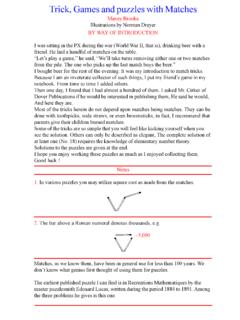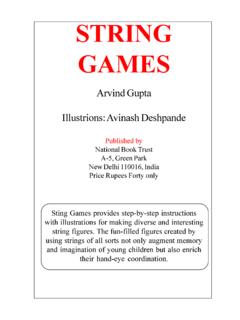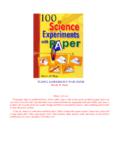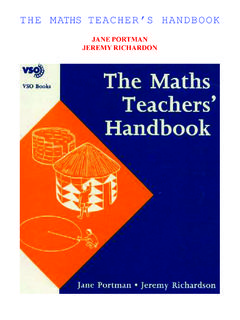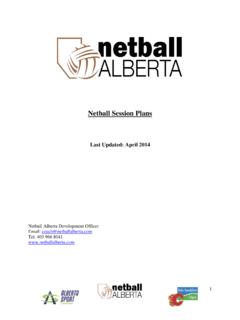Transcription of A HAND BOOK FOR TEACHING SPOR TS - Arvind …
1 A HAND book FOR TEACHING SPORTS(A VSO book )A handbook for TEACHING Sports is an essential guide for teachers, youth workers and community workers throughoutthe world who teach games and sport to children and young people. This practical book is especially useful for thosewith no background in physical education who work with large groups and with limited equipment. It is full of practicaladvice, including how to make equipment from locally available materials, and clear diagrams make the TEACHING pointseasy to handbook explains how to: teach the basic skills of different sports develop those skills from activities and mini-games to the full-scale sport run sessions for groups with different abilities and needs plan and organise sports activities and handbook contains the skills, practices and rules for thirteen popular sports including football, volleyball, roundersand 1958, more than 22,000 skilled volunteers have worked overseas with VSO in more than 60 countriesthroughout the developing world.
2 VSO Books publishes practical books and Working Papers in education anddevelopment based upon the professional experience of volunteers and their overseas importance of sport and physical educationMany people are interested in sports, particularly big events like the football WorldCup, the Olympic Games, and the African Cup of Nations. In schools throughout thedeveloping world, however, teachers face many constraints when they teach schools do not have specially trained sports teachers or much equipment, forexample many might only have one football. Students and other teachers might seesports as less important than academic subjects, and even if sport is a syllabus subject,teachers might not have training in how to teach and physical education can improve people s lives in many ways. Children inparticular will benefit from the opportunities sport can offer. Their experiences will staywith them through their lives and may be passed on to future generations.
3 Sport givespeople the chance to: get together and have fun everyone can enjoy the social aspect of taking part insport whatever their standard or ability experience success and achievement sport gives people the chance to improvetheir personal performances, fulfil their potential, participate in and win competitions keep fit and healthy sport can help physical conditioning, general fitness andwell-being learn physical and technical skills students can learn about the techniques ofvarious sports and how to improve their current skills develop timing, balance and co-ordination sport helps students develop theseskills, which will be useful after leaving school improve mental skills sport and competition encourages people to developproblem-solving and decision-making skills, concentration, determination, control ofemotions and commitment co-operate and communicate with others training and competing with others(particularly in team events)
4 Will encourage people to express and share their feelingswith others enhance motivation, organisation, leadership and interpersonal skills sportcan act as a way to develop these skills and take on responsibilities, which can betransferred to other aspects of life in the the end of thischapter you shouldbe able to explainwhy physicaleducation and sportis of value to youngpeople and thecommunity, andunderstand how touse this to use this bookWho is it for?This sports and physical education handbook is a guide for primary and secondaryschool teachers, and anyone involved with TEACHING young people sport, for exampleyouth and community workers and refugee camp workers, in developing countries. Youdo not need to have experience of TEACHING sports or a lot of expensive equipmentin order to use this book . Many of you may have no training in sports, very limitedresources and large numbers of students to teach at one time.
5 This book will help youteach sport whatever your situation. It can either complement a physical education syllabusor serve as a complete guide for TEACHING will it help?The book shows you how to teach sports to your students. It explains how to developskills and play games. There are many diagrams and pictures to help you understandthese. The information is very practical and will help you to run sessions that are fun andeducational. It covers many things you will need to know about when TEACHING sport, andexplains why these are important. Many of you will have different needs and thereforeyou are encouraged to use the information to suit your own circumstances, for examplein terms of resources, number of students, ages and starting levels. Throughout thebook we have used the experiences of and recommendations from VSOvolunteers and their national colleagues, working in schools and with youth areas does it cover?This book will help you teach your students how to enjoy and play a wide range ofdifferent sports.
6 You might be surprised that the book is not divided into a differentchapter for each sport. The best way to teach sports is through introducing games andskills that relate to certain sports and not by asking students to play a full game of a sportstraight away. This is because students have more opportunity in mini games to practisetheir skills because there are generally less people involved in a smaller playing area. Asa result they are far more likely to enjoy the games and improve their your students can master some basic sports skills, you can then go on to teachthem skills that relate more specifically to different sports. You will notice that these aregrouped together into invasive, net, batting and fielding, and athletic games. This is becausethere are many similarities between certain sports. For example, both hockey and footballare invasive team games where one team tries to invade the other team s territory andscore a goal.
7 Similar skills and tactics, such as running, dodging, passing, shooting anddefending, are used and it is important students begin to understand this as they learnabout skills are thefoundation skills foralt sports. Students(earn these skillsbefore they attemptmore specific example, ifstudents cannot catcha large round softball, they will certainlyfind it difficult to catcha rugby ball. Basicskills include: running and jumping throwing and catching hitting and of the rules for the various sports include mini versions as wellas the full game. These mini games are extremely valuable because theyhelp students to progress towards playing the full game. They give studentsthe opportunity to learn how to use their skills in a competitive situation,without all the pressures of the full game, such as covering a larger area,remembering more rules, having more choices of who to pass to andwhere. While these games are ideal for children who are learning skills,who are not yet strong enough, quick enough or skilful enough to copewith the full game, you should not be misled into thinking they are onlyfor younger or smaller children: everyone should be encouraged tostart by playing mini largest section of this book shows you how to teach your studentsmany sports activities and games, to help them learn about sport andgive them the opportunity to benefit from all that sport can offer.)
8 However,there are also other issues involved with TEACHING sport that you need toknow. Planning sessions, creating opportunities for participation andcompetition, and the way you teach are all very important. As you mayhave very few resources available, suggestions and advice on how tomake equipment is vital so that your students can enjoy many sports andhave as much involvement as possible in the different activities. This booktherefore covers the following areas: general TEACHING guidelines on planning, equipment, safety and takingthe session (Chapters 1, 2, 3 and 4) how to teach the basic skills of sport (Chapter 5) how to teach the skills required to play many different sports,including rules for basketball, netball, handball, football, hockey, rugby,volleyball, cricket, rounders, softball, long jump, 100 metres and shotput (Chapters 6, 7, 8 and 9) other useful information on organising competitions, officiating andsetting up clubs (Chapter 10).
9 How can it work for you?Whatever the age or ability of the students you are TEACHING ; thisbook provides suitable games for them to play. It will help your studentsprogress their skills so that they can play and enjoy a simplified/full versionof various sports. The progressions are referred to as stages. By the laststage of a skill, for example for goal-throwing games. Stage 5, 2 versus2 (see pages 62-63), you should be able to introduce students to asimplified version of the relevant sports and also the full version, accordingto the progress and ages of the students. You will find that the descriptionsfor each of the games include details of playing areas, safety and equipmentwhich take into account the constraints of available resources. There arealso diagrams to help you visualise how to play the different games andto highlight major TEACHING points. The sample session plans show youexamples of how to plan, structure and take sessions, using the activitiesshown.
10 The TEACHING points boxes suggest key questions and book gives you the flexibility of having a comprehensive guide forone particular sport or all of 12 sports, depending on your situation. Itgroups activities and rules for each sport according to type (invasive, net,striking, fielding or athletic games) and there may be subgroups withinthese, for example athletic activities are split into track and field will help you and your students to distinguish similarities and differencesbetween the sports, and learn how skills and tactics from one sport maybe transferred to refer to the Glossary on pages 158-1 59 for definitions of thekey terms used in this book . In particular, you should check the definitionsof sport, students and teachers, to see how they are used in this Planning a sports sessionWhy planning is importantGood sessions in sport do not just happen; they require goodplanning and organisation. Good planning can make all the differenceto the safety, enjoyment and success of a session.




